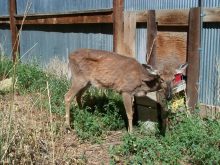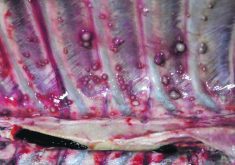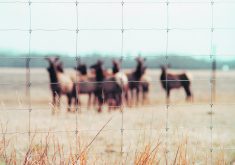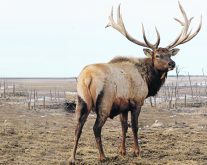Saskatchewan hopes hunters in boreal transition zones and on the eastern side of province will submit heads for testing
Big game hunters in Saskatchewan are asked to support the province’s efforts to monitor and control the spread of chronic wasting disease, a transmissible disease that affects the central nervous systems of deer, moose and elk.
Iga Stasiak, provincial wildlife health specialist with the Saskatchewan Ministry of Environment, said the disease is present across most of southern Saskatchewan, except for a few wildlife management zones on the east side of the province.
This year, hunters in wildlife management zones 2W, 9, 10, 35, 37 and 50 are strongly encouraged to participate in the program.
Read Also

Research looks to control flea beetles with RNAi
A Vancouver agri-tech company wants to give canola growers another weapon in the never-ending battle against flea beetles.
“These zones — the boreal transition zones and those along the (province’s) eastern border — are specifically targeted for testing this year, as there is a risk of the disease expanding in these areas,” the province said in a recent news release.
Heads can be submitted at designated drop-off locations throughout the hunting season.
Before submitting heads for testing, hunters must obtain a CWD tracking number from the cwdsk.ca website. For a complete list of drop-off sites or for additional details on how to submit a sample for testing, hunters should visit saskatchewan.ca/cwd.
In Saskatchewan, CWD was first detected in farmed elk populations in the late 1990s. A few years later, in the early 2000s, it was detected in the wild mule deer population.
Since then, the disease has spread throughout much of the province and has now been detected in deer, moose or elk in 59 of the province’s 83 wildlife management zones.
The Saskatchewan government has been tracking the spread of CWD through the hunter surveillance program for several years.
In the 2021-22 hunting season, more than 3,300 heads were submitted for testing, including 644 that tested positive for CWD.
Positive cases last year included 459 mule deer, 167 white-tailed deer, 16 elk and two moose.
The disease was detected for the first time in two additional zones last year — zone 37, along the provincial border between Saskatchewan and Manitoba — and zone 63, in the southern boreal forest.
Stasiak said hunters throughout the province will still be able to submit heads for testing. But emphasis is on selected zones, where additional submissions and data will be especially useful in tracking the disease’s spread.
“We are still offering province-wide testing to hunters… but we are particularly interested in certain areas of the province where we have not had adequate submissions in the past,” she said.
“There is specific interest in areas or zones along the Manitoba border… where we have really low infection rates because we are starting to see an increase in infection rates in this area…,” Stasiak added.
“Also, the boreal transition zone because we are seeing CWD moving further north and further into the boreal forest, so we’re trying to monitor that a bit more closely.”
Although there are no known cases of CWD infecting humans, it is not recommended that people consume meat from animals that have tested positive for the disease.
It is assumed that infected carcasses can be fed to dogs or cats without negative health effects.
CWD prevalence rates in mule and white-tailed deer populations have continued to increase since the detection of the disease in the wild more than 20 years ago.
Today, the disease is considered endemic in southern Saskatchewan.
Prevalence rates among male mule deer in the South Saskatchewan River Valley are in the range of 85 percent. In the same area, prevalence rates among female mule deer are in the range of 35 percent.
Infection rates in white-tailed deer populations are lower.
“We’ve seen a tenfold increase in infection rates in the last decade … and it really is continuing to increase, as we would expect, in those core areas and continuing to spread.
“In the South Saskatchewan River Valley, we have some of the highest infection rates in the world.”
In areas of North America where CWD prevalence is higher than 30 percent, research suggests decreased survival rates and population declines in mule deer and white-tailed deer populations.
In 2021, 16 cases of CWD were reported in elk that were taken in 14 different wildlife management zones.
There have been sporadic cases of CWD reported in moose as well, primarily in areas of the province where the disease is endemic in deer.
In 2022, elk and moose hunters are encouraged to submit heads for testing.


















